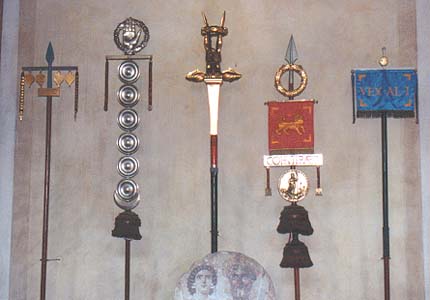
IMPERIAL AQUILA - SIGNUMS - VEXILLIUM
IMAGO - DRACO - STANDARDS
FEBRUARY 22, 2010

Standards within the Principia Treasury of the Saalburg Fort in Germany
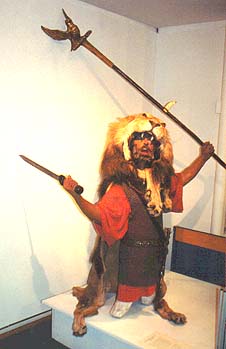
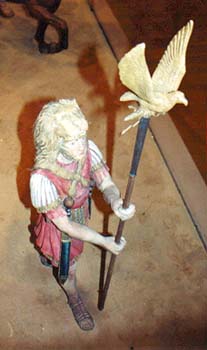
At Left - A depiction of a Aquilifer on his knees defending the Legion's Aquila Standard. Note the Lion's head and pelt over his helmet and body. The Legion's Aquila would be defended to the death. At Right - A model of a aquilifer carrying the Aquila Standard. Both displays are at the Museum in Dover, England.
The Century, Cohort and Auxiliary units of a Roman Legion, carried several different styles of Vexilla (banners), Signums and other types of "Standards" to identify themselves. These various standards were considered as sacred objects representing the spirit and soul of the unit. They were decorated with garlands and sacred oils on special days and occasions. The honor of carrying these "Standards" was entrusted to veteran legionaries who generally were serving their extended enlistments after 20 years of service. In Republican times, several icons such as the Eagle, Wolf, Bear, Boar or Minotaur were carried as the symbols of Republican Legions. Consul Marius established the Eagle or Aquila as the sole symbol of a Roman Legion as part of his "Reforms" of the Roman Military in 106 BC. For a Legion, the "Aquilifer" bore the Aquila-Eagle, while the "Imaginifer" carried the Imago of the Emperor. Each Century and Cohort unit would have a "Signifer" to carry its Signum and a "Vexillarius" to bear the unit's Vexillum banner. These standard bearers wore maile (hamata) armor instead of segmentata plate armor and generally are depicted wearing the heads and hides of Wolves "Lupae", Bears "Ursae", and in the case of a legion, maybe a Lion "Leo", over their helmets and armor. This is thought to have been a demonstration of the dominance of Rome over the forces of nature. They generally carried a round "Parma" style shield in deference to the usual rectangular "Scutum". In the Castra (fort) or other unit encampment, the standards of the Legion and its Units were housed in the Shrine or Treasury portion of the Principia (headquarters) building; where they were guarded day and night. The poles for the various standards would have a butt spike to allow them to be stuck in the ground and many had a handle or "grab" to extract them from the ground and to more easily carry them while on the march.
The re-created Standards shown further below are displayed at the Saalburg Fort, northwest of Frankfurt, and at the Romische-Germanische Zentral Museum in Mainz, Germany. They date to the late 1800's and are attributed to Dr. Ludwig Lindenschmidt, who was an early authority on the history and activities of the Roman Legions in Germanic Europe.
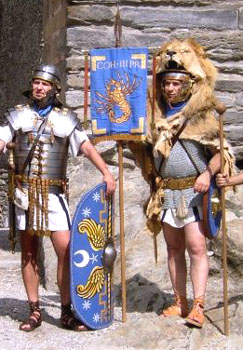
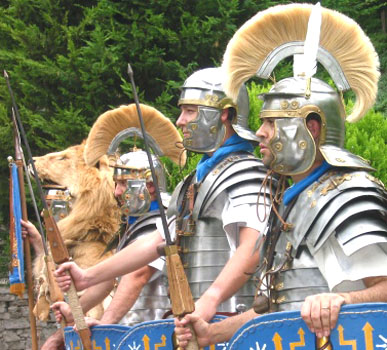
The Vexillarius of Cohors III Praetoria in Italy www.cisalpina.net in formation with the legionaries of the unit. Note that the Vexillarius is wearing maile (hamata) body armor and a very impressive lion pelt over his helmet. A Lion (leo) pelt is thought to have been generally worn only by the Aqualifer, Signifer or Vexillarius of a legion/legio unit. Bear (ursus) and Wolf (lupus) pelts were frequently worn by the standard bearers of century and cohort units.
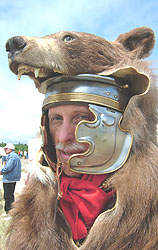

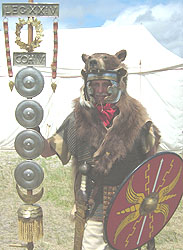
LEFT and RIGHT - Commander Marsallas with a Bear (Ursus) pelt over his Gallic-C helmet, as was commonly worn by Roman Signifers, possibly to denote Rome's dominance over nature. CENTER - Tiberius Fabius Rufio (Jeffery Crean) of Legion XX stands in as the Signifer for Legion XXIV. Note the Wolf (Lupus) skin worn over his helmet and ring-maile armor, and the round Parma style shield.

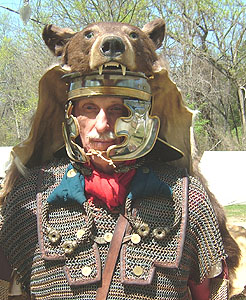
The Commander standing in as the Signifer for Legion XX wearing his bear pelt over a Gallic-C helmet during Marching Thru Time, April 2005 . The cinnamon colored omnivorous mammal's staring eyes seem to follow you as if looking for a meal. Bears / Ursae are thought to have been more common than Wolves / Lupae for Signifer and Vexillifer attire.
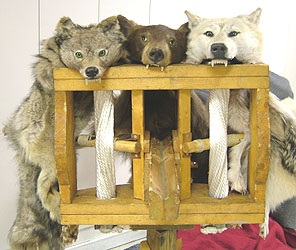
Two Lupi (wolves) flanking an Ursus (bear) glower from atop the Legion's "Engine of Terror" catapulta. The lupus on the right is owned by Roger Moskey of Legion XX and had just returned from the taxidermist near the Commander's Castra. It poses here with Legion XXIV's Lupus and Ursus prior to being shipped back to Roger in Virginia.
++++++++++++++++++++++++++++++++++++++++++++++++++++++++++++++++++++++++++++++
AQUILA (Eagle)
The most famous "Standard" was the "Aquila" (Eagle), the symbol of a Legion, which was carried at the head of the Legion formation when on the march by the "Aquilifer" and was staunchly protected on and off the field of battle. A legion which lost its Aquila or had it fall in battle was disgraced. The Aquila emblem generally had up-raised wings surrounded by a laurel wreath. It was mounted on a narrow trapezoidal base, which had horizontal stylized unicorns and lightening bolts extending from the sides.
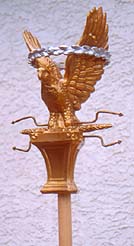


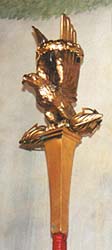
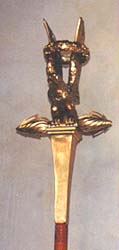
Legion XXIV 2000 / 2004 & XXIV Mid-West Vexil Aquila at Saalburg Fort in Germany
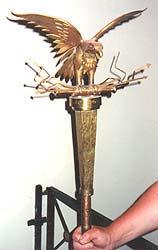


Rome Army Mus. Vindolanda Leg XXX (Ont) Leg XXIV Vexillum Top
++++++++++++++++++++++++++++++++++++++++++++++++++++++++++++++++++++++++++++++
SIGNUM (Military Standard)
A Signum Standard, is maybe more widely recognized as an icon of Ancient Rome than the Aquila; and is thought to have been carried by the individual legionary and auxiliary Century units of the Legion. The "massed" signums were generally carried at the head of the Legion while on the march. Each signum was unique to its "Century" and was composed of a number of philarae (disks), along with a number of other elements mounted on a pole, topped with a leaf-shaped spear head or a "Manus" (human hand) image. The Manus is believed to have designated the "Prior" (first) Century of a two-century "Maniple" formation; while the spear top would indicate the "Posterior" or second century of the "Maniple". The Maniple formation, composed of two 80+ man Century units, was used during the Republic; but fell out of favor in deference to the full Cohort formation of six centuries during the Empire Period. The Manus however continued to be displayed within Imperial Legions. One to six phalerae were displayed on a signum and the number of disks is thought to represent the number of the Century unit within the Cohort, as six century's composed a cohort and not more than six phalerae have been found in representations of signums from Roman times.



Legio XXIV Legio XX(Md.) Legio III Cyr (Ma.)

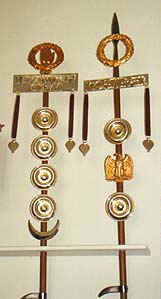


Saalburg Fort & Mainz Museum (Ger.) Vindolanda & Segadunum (Eng.)
Mounted above the phalerae grouping, was a rod or a plate bearing the units title from which were suspended two strips of leather similar to the apron straps of a legionary's cingulum or military belt; and sometimes a representation of a wreath probably denoting an honor or award. The wreath sometimes surrounded the Manus or spear head surmounting the standard pole.
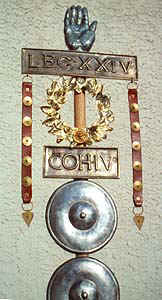
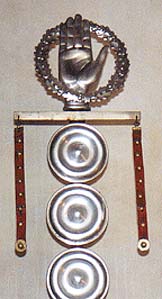
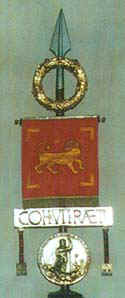

Legion XXIV Cohort IV Cohort VII at Saalburg Fort in Germany Leg XXII (Oh)
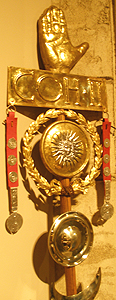
Leg III Cyr (Ma.)
Mounted below the phalerae or within the phalerae group, could be a crescent, possibly relating to Syria or the god Mithras (a favorite deity of legionary soldiers); a Capricorn emblem (Leg XIIII below) or zodiac image indicating the "birth sign" of the Legion during the year or other effigy relating to the origin of the unit.
A fringed inverted bowl was placed below the other elements and its purpose or meaning is not known. A hand grab was affixed low on the staff for ease of carrying the signum while on the march.
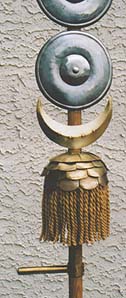
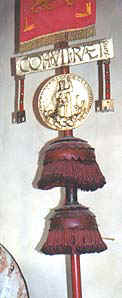



Legion XXIV(Pa.) Saalburg Fort, nr Frankfurt (Ger.) Legio XIIII (Ger.) Leg XXII (Oh.)
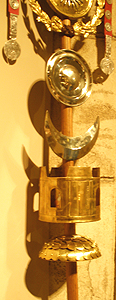
Leg III Cyr (Ma.)
++++++++++++++++++++++++++++++++++++++++++++++++++++++++++++++++++++++++++++++
VEXILLUM (Unit Banner)
A vertical hung banner identifying the Legion and the individual Legionary or Auxiliary units serving away from the main body of the Legion or Cohort. Such detached units were termed "Vexillations". The vexillum banner generally designated the Unit Type of "LEG"(Legion) or "COH"(Cohort) and the Unit Number in Roman Numerals along with an abbreviation representing the Cognomen (honorary title) that the unit may been awarded or had adopted. The icon of an animal or effigy was frequently placed on the vexillum as well. The Boar and Bull were quite popular as icons. Tassels hanging from the crossbar generally flanked the banner on each side and a fringe decorated the bottom margin of the banner. The predominant background color seems to have been red.
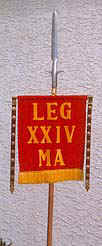
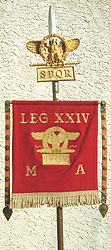
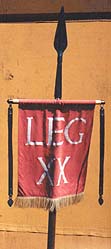
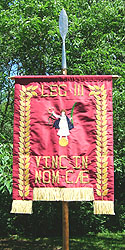
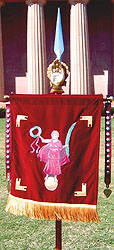
1998 Legion XXIV 2004 Legion XX (Md) Leg III (Ma) Lady Victory

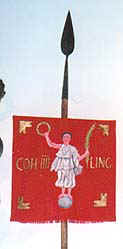
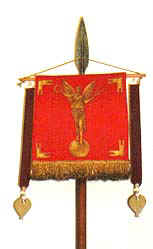
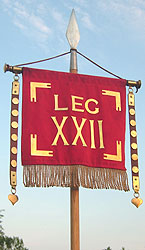
Legion XXX, Hamilton, Ont. Cohort IIII Segadunum Mainz Museum Leg XXII, Ohio
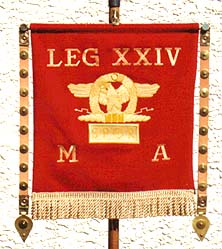
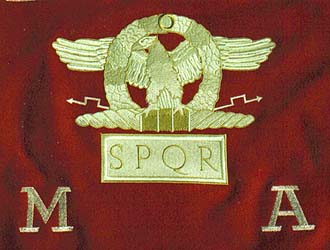
The New Legion XXIV Vexillum banner of March 2003. The center embroidered "Eagle-SPQR" image and banner were supplied by Nix Imperial Creations. The "Leg XXIV - M A" embroidery was added, resulting in a total of over 200,000 embroidery stitches! The banner with side tassels and hanging hardware was completed by the Commander. An "Aquila SPQR" topper was added to the Vexillum Standard in 2004. Banner dimensions are: banner is 17" wide x 21" long over tassels - cross-bar is 21" wide - tassel straps are 1" wide.
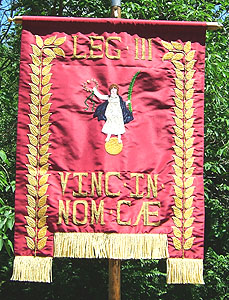
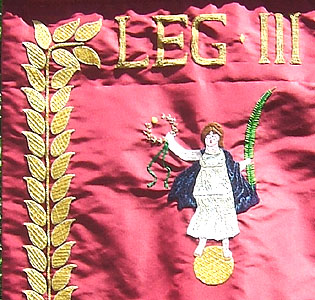
The Vexillum Banner of Legion III "Cyrenaica" is a true work of art! It was hand embroidered by Joe Gallant of III-Cyrenaica with some 60,000 manually placed stitches of gold bullion thread! The Legion's cognomen (nickname) "Cyrenaica" refers back to the original Legion III's campaigns to bring Cyrenaica (Eastern Libya) under Roman rule for Julius Caesar circa 46 BC, hence the "Vinc In Nom Cae" shorthand notation translating to "Conquer in the Name of Caesar". The figure is a representation of "Lady Victory". The banner is 13.5" wide by 19" long, including the fringe.
++++++++++++++++++++++++++++++++++++++++++++++++++++++++++++++++++++++++++++++
IMAGO (Emperor Image Icon / Astrological Image Icon)
Each Imperial Legion would have an Imago, carried on a staff at the head of the Legion by a Imaginifer. The Imago was a metal three dimensional portrait representation of the Emperor than in power or of the Emperor who had "raised" or "formed" the Legion.
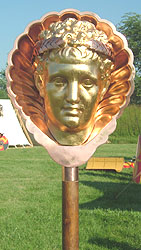
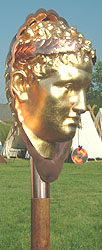
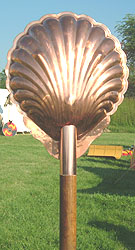 b
b
Front, Side & Rear views of an Imago of Legion XXIV representing no particular emperor or deity. It was constructed in 2006 by Joe and Thomas Perz, assigned to the Legion's Mid-West Vexillation.
Astrological images would sometimes be carried as well by the various Cohorts, Centuries or Auxiliary units within the Legion. These astrological icons such as a bull, ram or capricorn were carried on a separate pole standard or were mounted on other standards such as the Signum. They generally represented the period of the Zodiac under which the unit had been formed. Some icons could also refer back to tribal origins.

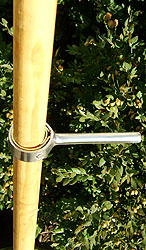
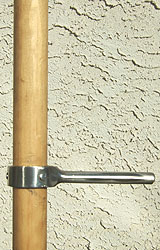
Leg-XXIV "Taurus" Bull Imago ** A hand grab was placed low on the staff of this and many other standards to aid in carrying them while on the march.
888888888888888888888888888888888888888888888888888888888888888888888888888888888888888
DRACO (Cavalry Dragon / Snake Head Standard)
Draco Standards were adopted during the Late Empire, 250-400 AD and were generally carried by cavalry units. The hollow head, in the form of a toothed dragon, or snake head was formed from metal and when carried by a rider at a gallop, the wind passing through it would extend a cloth tube tail attached to the neck of the head. There is indication that the air-stream passing through a Draco head carried "at speed" could create a hissing, whistling or droning sound. The Draco was carried by the so-called "Draconarius" rider of a cavalry unit. Draco standards were also used in cavalry "Gymnasia" (games), such as the "Hypakka" where points were scored for strikes (from dummy pilum javelins thrown by another team of "Aggressor" riders) on the tail piece of the Draco standards being carried by the Draco Team acting as "targets".
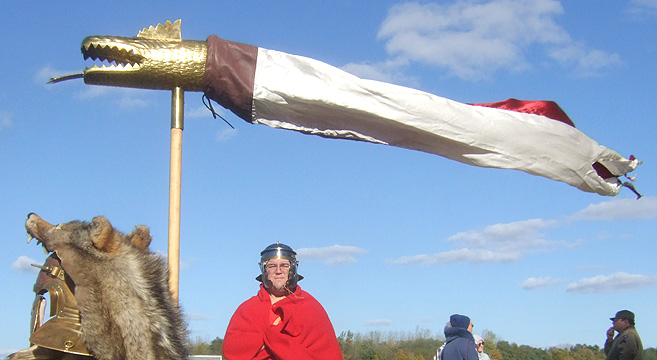
Legion XXIV's Draco Standard "shows-off" in a stiff Autumn breeze at the Historic Soldier Event in Burlington, NJ, Oct-2007 draco-020

The Draco Head of Legion XXIV casting its silhouette on a nearby wall. This impressive piece was commissioned by the Commander and was masterfully executed by Joe Piela of Lonely Mountain Forge in November 2006. It is based on the Draco head on display in the Mainz Museum in Germany. Note the double forked tongue extending from the dragon's mouth, which the Mainz Draco does not have, and the nostrils on the tip of its snout. Here the Draco head does not yet have the cloth tube tail attached. Additional views of the Legion XXIV Draco are posted further below. draco-010 235 x 655

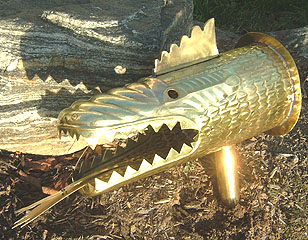
Legion XXIV's glaring "Draco" is silhouetted in the late afternoon sun. LEFT - As delivered with single narrow tongue. RIGHT - With a more menacing double forked tongue enhancement by the Commander. draco-021,022 240
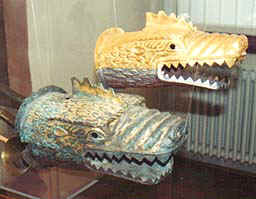
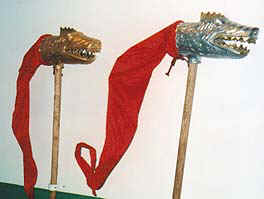
Draco Standards in Mainz Museum, Germany & Segadunum Museum, Newcastle, England
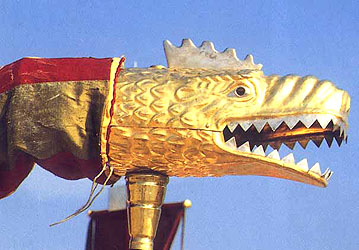
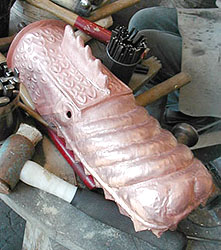
Draco reproduction by Dr. Marcus Junkelmann, Germany *** Draco by Tim Blades, source: Fectio.org.uk
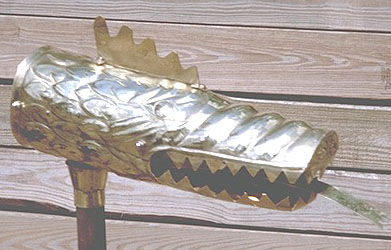
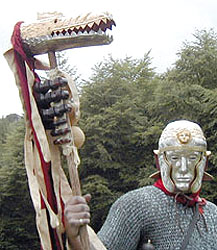
Draco head by Joe Piela of Lonely Mountain Forge. Note the extended tongue. *** Tim Blades Draco standard with whistles mounted on the staff to create sound which the Draco standards are reported to have made when carried by horseman at a gallop. source: Fectio.org.uk
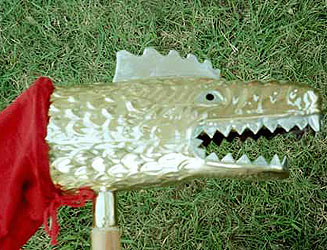
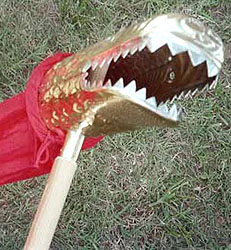
Two views of a Draco reconstruction by Michael Simkins, UK
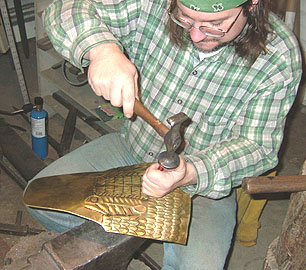
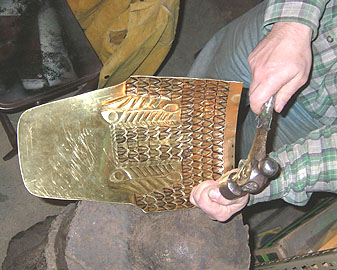
Joe Piela of Lonely Mountain Forge working on the Legion XXIV Draco Head. He has drawn a pattern on the back-side of the work piece and is using various sized, curved and shaped chisels to make repeated dents and creases on both the front and back sides to gradually impress the "repose" pattern. Note how the brass sheet takes on a natural curve as it is worked over a hard, but pliable ball of pitch, which allows the brass sheet to yield and take the impressions during a long, slow and exacting process. draco-011,012 270
++++++++++++++++++++++++++++++++++++++++++++++++++++++++++++++++++++++++++++++
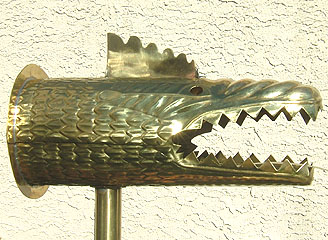
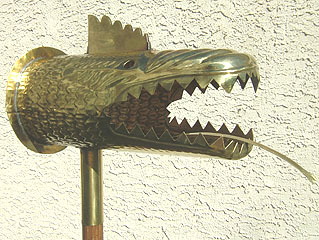
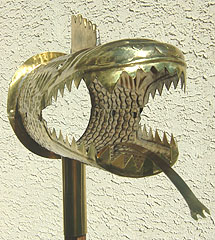
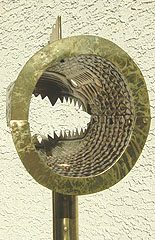
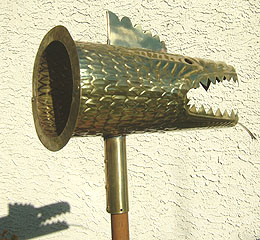
Views of the Legion XXIV "Draco" as originally made with a single narrow tongue extending from its gaping mouth. draco-001,002,003,004,005 240
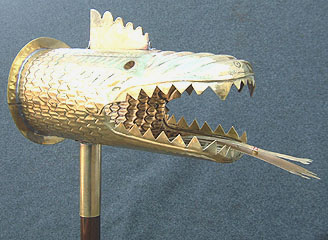
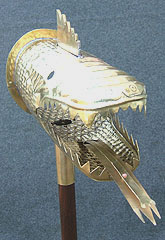
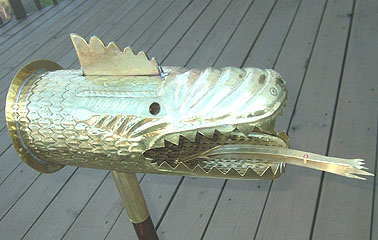
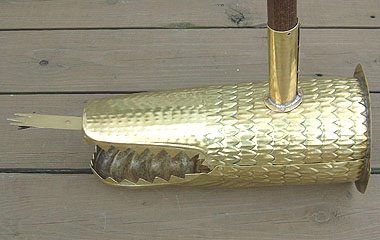
The Legion XXIV Draco as modified by the Commander with a wider second tongue placed beneath and augmenting the original narrow tongue. The resulting "split-tongue" enhances the intended fierce appearance of the Draco. draco-006,007,008,009 240
88888888888888888888888888888888888888888888888888888888888888888888888888888888888888
*** HOME *** SITE INDEX *** TOP ***
** ROME HISTORY ** LEGIONS OF IMPERIAL ROME **
You have been identified as the
to visit this Page of our Legion XXIV Website since October 22, 2002.